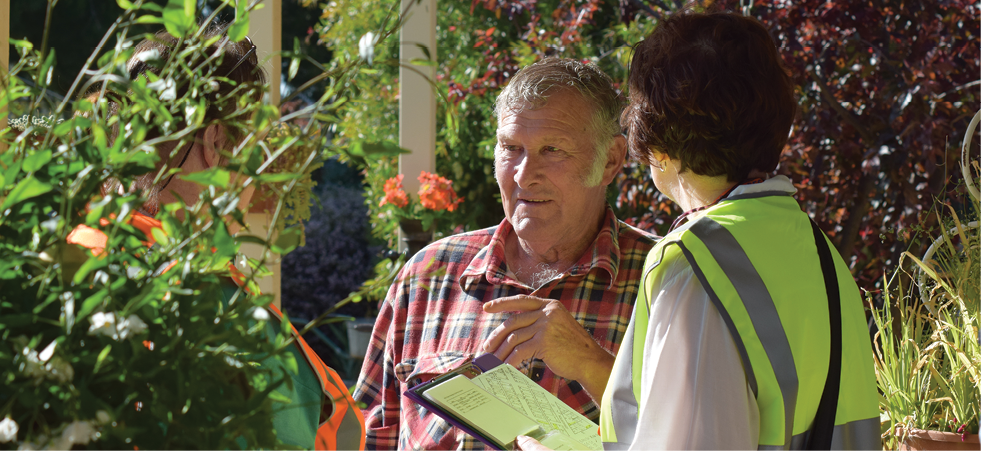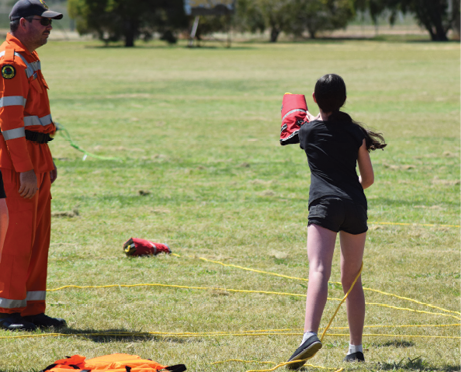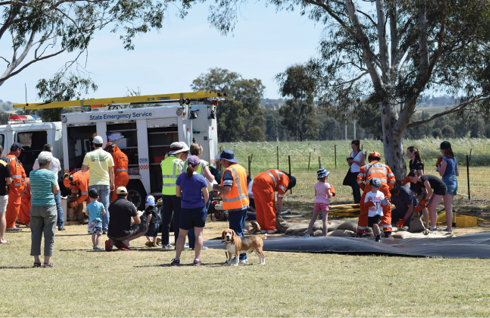
By Ian Leckie, Community Engagement Coordinator and Andrew Richards, Manager Community Engagement NSW SES
The township of Uranquinty is situated near Wagga Wagga, on the NSW-Victoria border. The town’s 715 residents live on a flat catchment without a flood gauge. There is often little warning of a flood other than rainfall predictions and observations. Heavy rainfall falls in the surrounding area and flooding affects up to 80 properties and frequently cuts access routes into Wagga Wagga. In 2010 homes in Uranquinty were flooded and in 2012, flooding caused significant evacuations. Residents realised that a collaborative effort to preparing for floods would produce better property protection and evacuation results in future.
The Uranquinty Community Safety Group (UCSG), an offshoot of the town’s Progress Association, was recruited, formed and developed a flood action plan supported by the NSW SES. This took place over a five-month period and culminated in a community-led disaster simulation exercise.
Local buy-in, ownership and involvement was vital. Local suppliers, people at-risk of flooding, and local organisations, such as the Wagga Council and Origin Energy, were approached to participate in and to provide financial and in-kind support.
A representative from the Uranquinty Progress Association approached the SES during a presentation in Wagga Wagga to ask for NSW SES support to prepare and plan for the next flood. Other residents from Uranquinty were recruited to join the UCSG.
Monthly meetings were held to formulate and establish the plan for the next emergency. The UCSG discussed tactics about notifications to the community and plans to evacuate residents, often applying lessons from overseas and local flood events. The committee decided to conduct an exercise on Sunday 19 October to test the plan.
Work on the plan intensified in September and October as phone trees, maps, flowcharts, helpers, teams, contact lists, tactics and timings were refined. Local media were enlisted to help cover the day.
Exercise Wirraway was held on Sunday 19 October 2014 from 8.30am to 2.00pm. The day started with a ‘Flood Bulletin’ from the NSW SES that triggered committee members to activate a phone tree and call residents who may be most affected. Teams of community members were sent to knock on the doors of over 80 properties providing information and instructions on the ‘evacuation’ as well as gathering other information such as contact details and discussing preparedness advice.

A member of the UCSG activates a community phone tree after receiving a flood warning from the NSW SES.

Belinda McMahon and other members of the UCSG each led six teams of locals, who were mobilised to doorknock and evacuate residents. This also provided an opportunity to build rapport, impart and gather information.
Residents were encouraged to ‘evacuate’ to the community hall by midday where a community barbeque was arranged. About 100 people met at the community hall to learn about building sandbag walls, some flood rescue skills, and how they could help one another during times of emergency. A number of water rescue ‘throw-bags’ were given to Uranquinty by the SES in appreciation of the efforts they had made.
The UCSG has pledged to review and fine-tune the arrangements annually to ensure the plan stays fresh and accurate and residents stay aware of what to do. The group is also planning for other emergencies that may affect the town.
This approach challenges traditional thinking about emergency management. Disasters have been regarded historically as a government responsibility leading to agency ownership and community reliance on emergency services for help. This new approach aims to reduce the impact of emergencies on communities by increasing community ownership and building community resilience.

Local children learn from NSW SES members how to safely rescue people from floodwater using a throw bag. This technique allows the rescuer to remain on the shore during the rescue, thereby reducing their exposure to risk.
This is especially relevant where there are low numbers of local volunteers, a reduced SES presence, or where events are too rapid to allow a timely response by emergency services organisations. The success of community-led approaches is often enhanced where existing and motivated community groups and resources can be activated, or to redirect community spirit following a recent disaster.


Members of the Uranquinty community learn how to fill sandbags and build their own effective sandbag wall to help stop floodwater entering properties.
The UCSG has since gone on to plan for other potential disasters including bushfire and a major transport disaster, each a significant risk for the town. During a recent After Action Review with the NSW SES, Uranquinty residents acknowledged that applying local knowledge to local solutions has brought them closer together as a community and they feel they are better placed to manage future events.
The NSW SES receives support for this type of approach. NSW SES has applied similar successful activities in other communities including Port Macquarie-Hastings, Tumblegum and Uki, as well as observed efforts undertaken in other states. The next phase of this community involvement will be to consolidate a range of approaches into a suite of tools for SES members to apply in different community contexts and risk profiles.
Contact: Andrew Richards, andrew.richards@ses.nsw.gov.au.